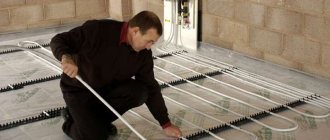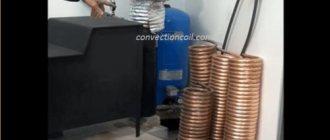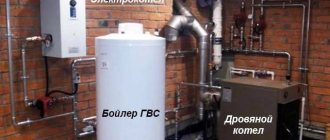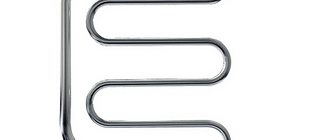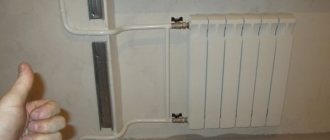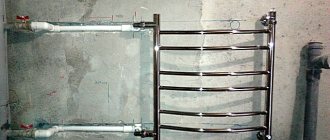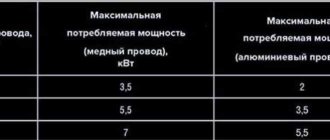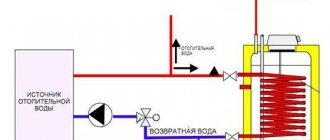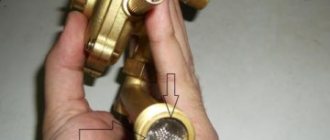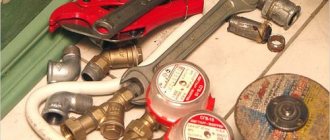The transfer of a heated towel rail is carried out during repairs or when remodeling a bathroom or a combined bathroom. In some houses, the pipe is part of the heating system, and then the transfer procedure will need to be agreed upon with the management company. In other cases, you do not need to obtain permits to carry out work.
Relocating a heated towel rail during repairs.
Standards and requirements for moving a heated towel rail
Requirements for the installation site and the equipment itself:
- The partition to which the heater is supposed to be moved should not be adjacent to the living rooms or living room.
- It is not recommended to move the heated towel rail over a long distance, since additional pipes reduce the water pressure.
- Steel or metal-plastic lines used for switching must withstand elevated temperatures and increased water pressure.
- The body of the heated towel rail should not have welded seams that could be destroyed by a sudden supply of water (water hammer).
When installing an electric heater, the power consumption is taken into account, which should not exceed the permissible load for the existing power circuit. If the equipment has increased power, then it will be necessary to organize a separate power supply branch equipped with protective elements. The socket body is selected according to the current strength in the circuit, which determines the degree of heating of the contacts and the dielectric core. If the selection is made incorrectly, the socket overheats and catches fire, accompanied by a short circuit.
Pipes should not be placed too far apart from each other.
Moving a water heated towel rail, what difficulties arise
Firstly, legal problems may arise with permission to move, and secondly, when moving a water apparatus, problems may arise with the load of the new structure on the water supply system of the house.
All other difficulties are not serious compared to the first two.
Before starting the transfer, be sure to turn off the supply riser. It is not recommended to do this yourself; it is better to entrust it to a professional plumber.
Typically, water devices do not have a heat control system, but you can install a ball valve on it, which will allow you to regulate the heating of the installation.
If you transfer the installation and do not agree with the housing inspectorate, you will be held administratively liable. The case may go to court, and you will have to be punished or get off with a fine for a tidy sum.
Watch the video for an interesting and safe option for connecting a heated towel rail:
Who is the work coordinated with?
Before moving the heated towel rail, you need to decide on the principle of heating the water. If the design uses a spiral with electric heating, then coordination of the work is not required (the heater is not connected to the water lines). A power cable with an automatic fuse is laid to the installation site; safety regulations are observed during installation. If the heating device is connected to a hot water supply or heating pipe, then you need to obtain approval for the transfer from the management company.
List of documents required to obtain a permit:
- identification document of the applicant;
- certificate confirming ownership;
- a free-form application containing a list of works;
- technical passport of the apartment;
- conclusion of the expert commission confirming the possibility of redevelopment.
Apartment registration certificate.
The conclusion on the transfer of the riser is drawn up by employees of the housing inspection based on the apartment redevelopment project. In a number of localities in the Russian Federation, documents are issued by the management company based on the owner’s application. The legalized procedure for moving a water heated towel rail relieves the apartment owner of the risks associated with disruption of the normal operation of the heating or hot water supply system.
How to prepare for the transfer
To move the heater to another wall you will need:
- electric drill or hammer drill;
- drill or drills for working on concrete;
- spanners;
- building level;
- tape measure or pencil;
- equipment for installing water pipes (welding machine or installation for soldering polypropylene elements);
- materials for connecting and sealing highways;
- test device (in case of connecting an electrical device).
You will need a hammer drill for the job.
If you plan to install a heater with an electric coil, then a power outlet is located at the installation point. The cable is routed under finishing materials (for example, tiles); it is allowed to fasten the wires in plastic boxes located on top of the finishing walls. For switching, a cable of the VVG-Ng series is used, equipped with a grounding conductor. The cross-section of the conductors is selected according to the power of the heating device.
General recommendations and rules
When installing a heated towel rail, the standards described in SNiP standards are taken into account:
- The upper crossbar of the heating device is located at a height reachable by the hand of an adult. It is recommended to place the heater sections at heights from 900 to 1700 mm (the value of the lower threshold depends on the configuration of the product).
- If a U-shaped element is being installed, then the lower elbow is located at a height of at least 1100 mm from the floor covering.
- When installing an M-shaped heater, the distance from the floor to the lower section should not be less than 900 mm.
- The metal body of the heat exchanger, made of steel, must withstand a pressure of at least 7.5 atm. The water pressure in the mains depends on the number of floors of the building and the distance from the house to the pumping station or boiler room. It should be taken into account that at night the pressure increases due to the reduced water consumption of residents.
- When choosing a towel dryer, take into account the size of the bathroom. Spaces with reduced dimensions require a heater with small dimensions (for example, models with a U- or S-shape configuration). The diameter of the heating element must correspond to the dimensions of the water supply lines.
- It is recommended to provide a gap between the lines and the wall in the range from 35 to 55 mm. The supply pipeline is installed at an inclination of 2-3°, ensuring automatic removal of air or steam plugs.
M-shaped heater.
How to choose a heated towel rail
When choosing an installation, you should pay attention to imported devices.
Models made in Germany and the Czech Republic are in demand on the market; they are of higher quality than those from domestic manufacturers.
When choosing, special attention should be paid to seamless models.
When choosing, we take into account that the best option is a product made of stainless steel or a more expensive one made of brass.
But if you live in a country house or cottage, you should trust the heating and drying of towels to models made of ferrous metal or brass. If the quality is good, such a device will last more than twenty years.
Let's watch a video on how to choose the best model:
Moving the dryer to another wall
Towel dryers are divided into categories according to the method of heating the surface:
- hot water flowing inside the line;
- using oil heated by a coil connected to the electrical network.
Water variety
Liquid heated towel rails are connected to water supply lines or heating lines. If the apartment has a centralized hot water supply, then it is recommended to embed the heater into the pipe break. When using a heating circuit, year-round use of the heated towel rail is not possible. It should also be taken into account that if an element is damaged in winter, the heating riser in the entire building must be turned off.
To install a water heater you must:
- Determine new equipment attachment points and mark the wall in accordance with the dimensions of the dryer.
- Turn off the water supply in the apartment or house. It is recommended to notify neighbors in advance about a temporary shutdown of water supply (for example, by placing a notice on the door to the entrance or in the elevator car).
- Cut the pipes using a grinding wheel or unscrew the mounting flanges (depending on the condition of the threaded connections).
- Unscrew the screws holding the brackets securing the heater to the wall. Holes in the tiles should be sealed with cement mortar or covered with decorative elements.
- Lay lines to the equipment installation site. If steel elements are used, the parts should be connected by resistance welding or special threaded couplings; the connection points are sealed with tow or synthetic tape. Plastic lines must be connected by soldering using a special device. Ball valves are provided in the fluid supply and discharge channels; there is a jumper (bypass) in front of the valves, which allows you to maintain water circulation when the towel dryer is turned off.
- Connect the heated towel rail unit with couplings; a special “American” type connector is used to connect the metal line to the plastic pipes. The coupling is screwed onto the thread on the heated towel rail and then soldered to the polypropylene lines.
- Install the mounting brackets that need to be fixed to the wall surface with dowels and screws. Use an electric drill or hammer drill to drill holes.
- Supply water to the mains and make sure there are no leaks. If drops of water are detected, the elements must be reconnected.
- Cover the water mains with a decorative box that provides inspection hatches (for example, for access to valves). If the room is being renovated, the pipes are embedded in the walls and covered with tiles.
Electric type heated towel rail
The electric heated towel rail is not connected to the water supply system, which simplifies the transfer procedure. Since the equipment is connected to a 220 V AC network, the installation point is located at a distance of at least 600 mm from faucets or shower heads. A socket with a waterproof housing, equipped with grounding contacts, is mounted on the wall. The power circuit is provided with an automatic fuse and RCD protection.
Electric heated towel rail.
Algorithm of actions when installing an electric heated towel rail:
- Remove the heater from its old location, seal the holes in the partition with decorative plugs or fill with tile grout.
- Mark the mounting points on the wall surface. It is recommended to install the heater at a distance of at least 950 mm from the floor surface and at a distance of 750 mm from the edges of furniture installed in the bathroom.
- Drill holes; For processing tiles, a special drill with a carbide tip is used.
- Install plastic dowels into the channels, and then fasten the heating equipment fastenings with screws.
- Connect the power and check the operation of the heater under different operating modes. It is not allowed to operate equipment with a leaking housing or with a faulty temperature controller.
Technical nuances of the transfer
The need to move a heated towel rail inside the bathroom arises in several cases:
- combining a bath with a toilet with the demolition of the partition between them;
- inconvenient default location of the heating device;
- moving plumbing fixtures and furniture inside the bathroom.
In the first case, you must obtain permission for redevelopment from the housing authority. After dismantling the partition, the riser must be moved to any of the remaining walls of the new room from its center. In the other two cases, the riser remains in its place, and the “towel” register is transferred to the adjacent or opposite wall.
The performance of the heating device and the quality of the bathroom design depend on the connection diagram. The correct choice of pipe material is the key to safety, long-term service life, and ensuring the maintainability of the system.
Riser
After the collapse of the partition between the bathroom and the toilet in order to combine the two rooms, the riser must be moved to the remaining existing wall in the combined bathroom. This is the most difficult repair option due to the following nuances:
- for lower/upper neighbors the riser remains in place;
- bends are used for displacement;
- the lower outlet must be recessed into the lower floor slab, and the horizontal line must be embedded in the screed;
- the upper outlet can be placed under the upper floor slab without recessing it;
- in this case, in the combined bathroom you will have to build a suspended panel or slatted ceiling, make a structure from plasterboard or use a PVC stretch fabric.
In this option, it is recommended to use a classic PS configuration - U-shaped or W-shaped. In “ladders” there may be problems with circulation due to increased hydraulic losses in numerous outlets/branches.
For U-shaped and M-shaped registers, the requirements are less stringent. For example, in the secondary real estate stock (“Khrushchev”, “Brezhnev”, “Stalinka”) such heating devices were mounted on a riser without a bypass.
Currently, the bypass is a mandatory part of the riser for connecting a heated towel rail. That is, the heating element cuts into the riser with tees in parallel. For "ladder" type substations with large hydraulic losses inside them, the bypass part of the riser is made narrower - one standard size smaller.
In this case, hydraulic losses occur in the riser itself; the coolant enters the heated towel rail circuit more easily. Normal circulation is ensured.
Some models of heated towel rails are equipped with their own bypass. However, for ease of maintenance of the device during operation, taps or valves are installed in front of it. Therefore, the bypass in this case does not meet the requirements of SP and SNiP standards.
Connection diagram
The main requirements for ensuring normal coolant circulation in an offset heated towel rail are:
- the top insert into the riser must be located above any top element of the “towel”;
- the lower insert into the riser must be below the lower element of the heated towel rail;
- The routes of the horizontal supply and return lines between the riser and the substation must be straight.
This will ensure that there are no “air pockets”; the heating device will start up normally without air pockets after draining the water from the system and then filling it with coolant.
When moving the PS under the bathtub, you should not hide horizontal lines or embed them in the screed.
Important: In Government Decree No. 508, in paragraphs 10.3 and 10.11 of the first appendix, horizontal grooves in load-bearing walls are strictly prohibited. Therefore, the wiring will have to be hidden behind false plasterboard panels. However, in bathrooms, partitions are usually used in which gating is permitted.
Pipe material
There are two main problems when choosing pipe material:
- by default, all heated towel rail risers in new buildings and secondary apartments are equipped with grounding systems;
Safety precautions
When installing a dryer with an electric heater, it is necessary to ensure safe operation of the equipment:
- wiring is hidden in the wall or in boxes;
- contact connection points are protected by insulating materials;
- a protective shutdown device is provided in the power circuit;
- The socket is equipped with a grounding line to which the metal body of the heated towel rail is connected.
The socket must be protected.
The socket housing must meet IP4 or IP65 protection standards. The design does not allow dust and splashes of water to penetrate into the internal cavities, but if a jet of liquid enters, a short circuit occurs. It is recommended to place the outlet in an area inaccessible to water (for example, under the ceiling of a bathroom).
